Category: Non classé
DONA, YANN AND THEIR CREW TO SET SAIL ON A FOSSIL FUEL-FREE JULES VERNE TROPHY ATTEMPT
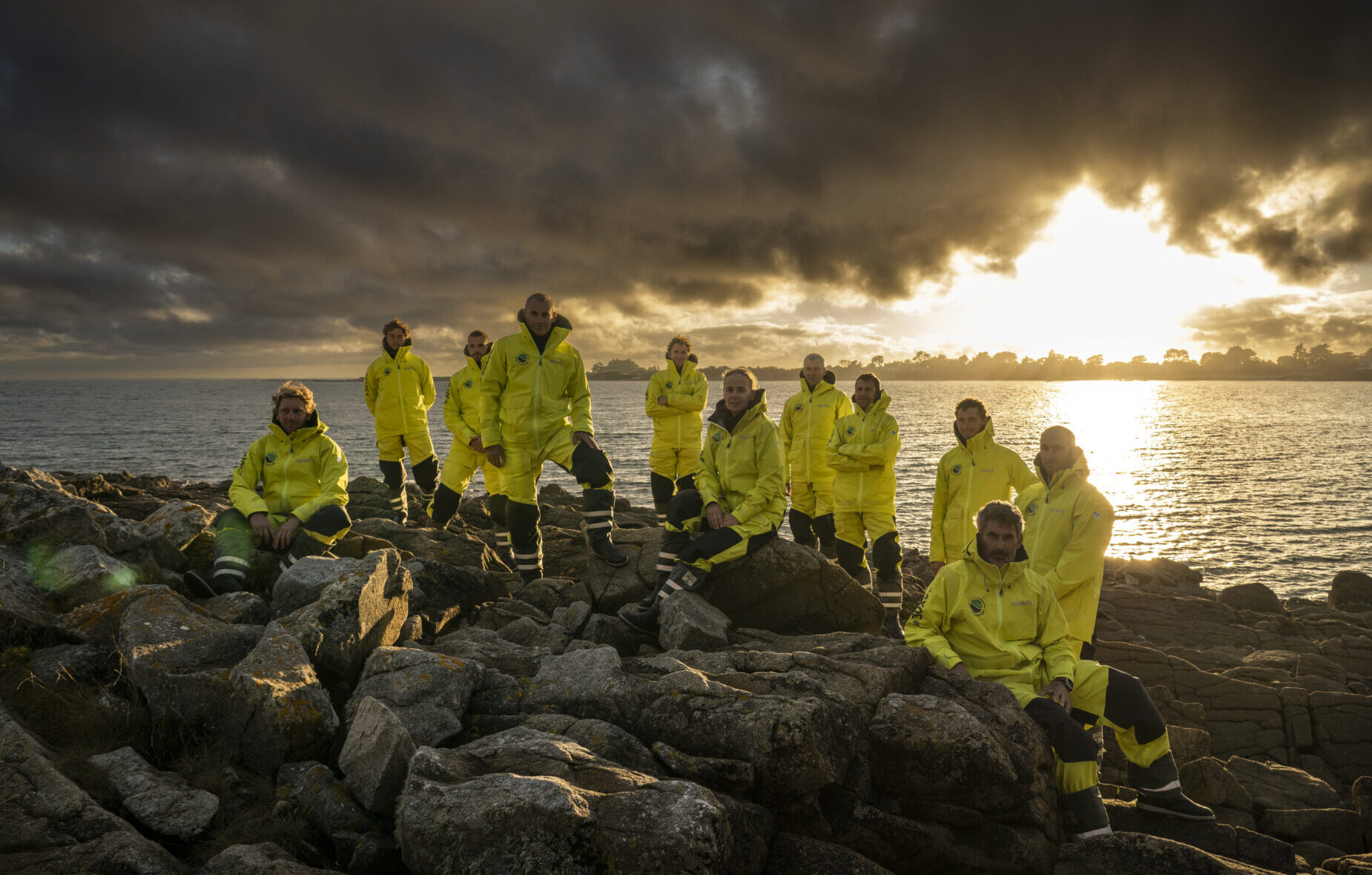
Dona Bertarelli and Yann Guichard are once more set to take on the Jules Verne Trophy, held since 2017 by Francis Joyon and his crew in a time of 40d 23h 30’ 30’’. Remodelled for improved performance over the course of last winter, Sails of Change (ex-Spindrift 2) maxi-trimaran will be sailed by an 11-strong crew.
This will be Yann Guichard’s fourth attempt as skipper on this round the world passage under sail, and he is taking on two challenges as he aims to both secure the Jules Verne Trophy and produce all their energy requirements self-sufficiently. Indeed, for the very first time, the whole journey will be undertaken with no auxiliary engine.
“We’re going to take on an additional challenge, since we’ll be attempting to break the round the world record without using any energy produced using fossil fuels. Our main sources of energy will come from the sun and wind, as well as an on-board bike-powered generator. We are keen to show it’s possible” – Yann Guichard.
This new energy challenge accompanies a series of technical solutions introduced over the winter, which relate to the cockpit, aerodynamics and central hull, the latter having been shortened by three metres. This latest modification provides improved balance at the helm and reduces vibration aboard the largest racing multihull ever built (37 metres), which has been renamed specially for this attempt: Sails of Change.
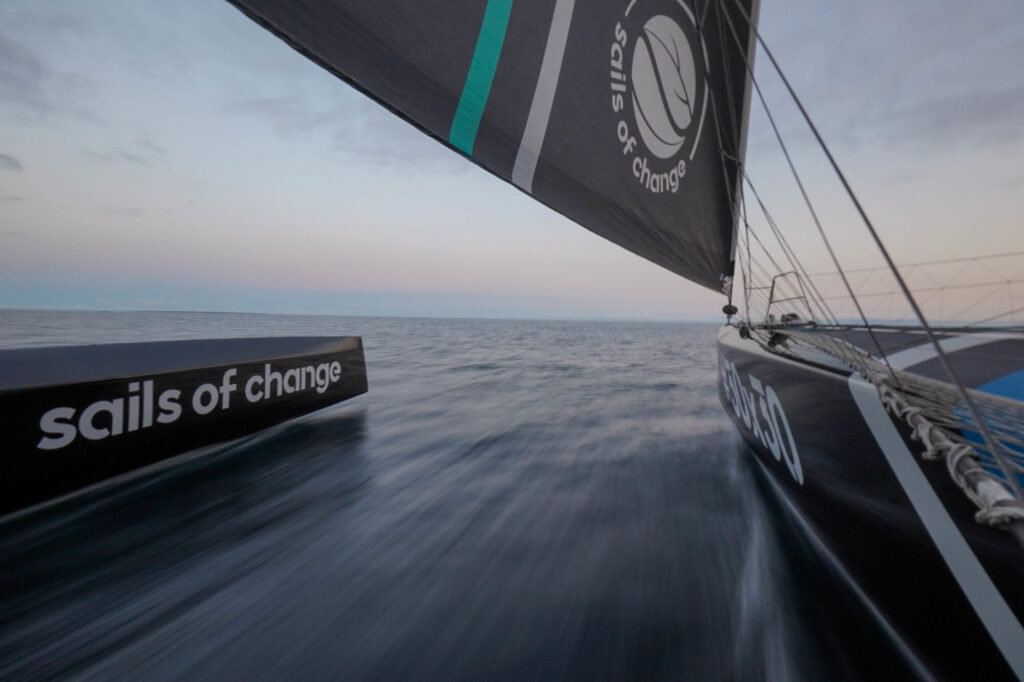
About Sails of Change
Sails of Change is a community of sport and nature lovers, who want to create a sustainable future for our planet. Founders Yann Guichard, Dona Bertarelli and her children are committed to sharing ideas and information, as well as creating partnerships to protect and restore the environment, and working for a sustainable future for all.
The first campaign supported by Sails of Change, ‘30×30’, is a global call to action to protect at least 30% of the ocean and land by 2030. The maxi-trimaran will carry this message around the world, with #30×30 logos emblazoned on her sails and hulls, together with distinctive blue and green colour-coding for the new livery on the racing stable’s flagship.
“Through the medium of a sport that we love, I invite everyone to embark with us on this human adventure, discover the beauty of nature and join us in our circumnavigation of the globe,” says Dona Bertarelli, on-board reporter for this latest attempt.
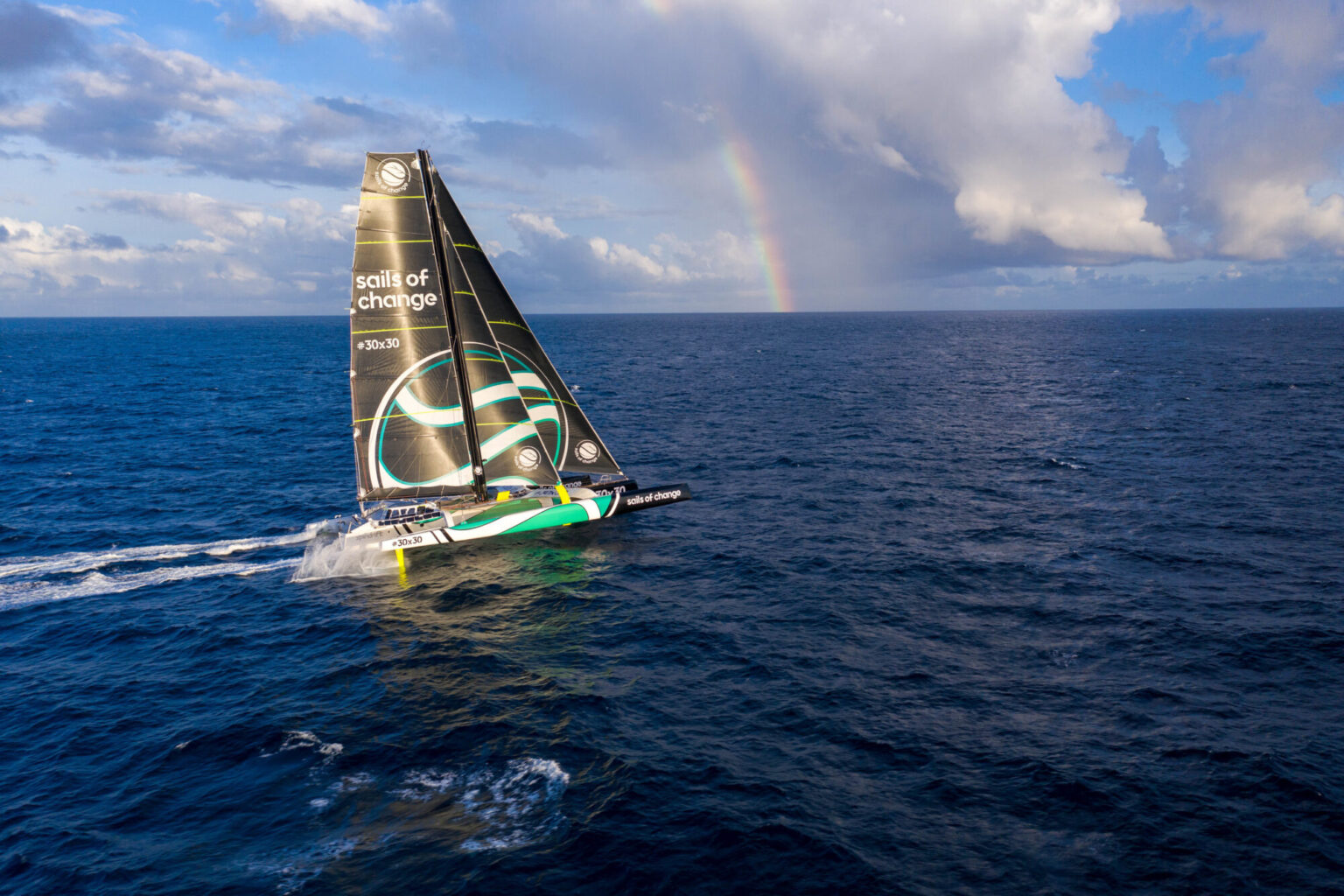
About Spindrift for Schools
The Sails of Change maxi will also fly the flag of the Spindrift for Schools educational programme, whose educational kit “Inspired by Nature: committed to action!” has just been published in partnership with the Departmental Service of National Education of the Morbihan region, the French Réseau Canopé in Lorient, Brittany, and with the support of UNESCO.
“Our aim is to inspire, raise awareness and prepare young people as they become the adults of tomorrow. We hope that through our passion and our commitment to nature, we can share knowledge and values to support children as they learn to work together and commit to their future,” explains Dona Bertarelli.
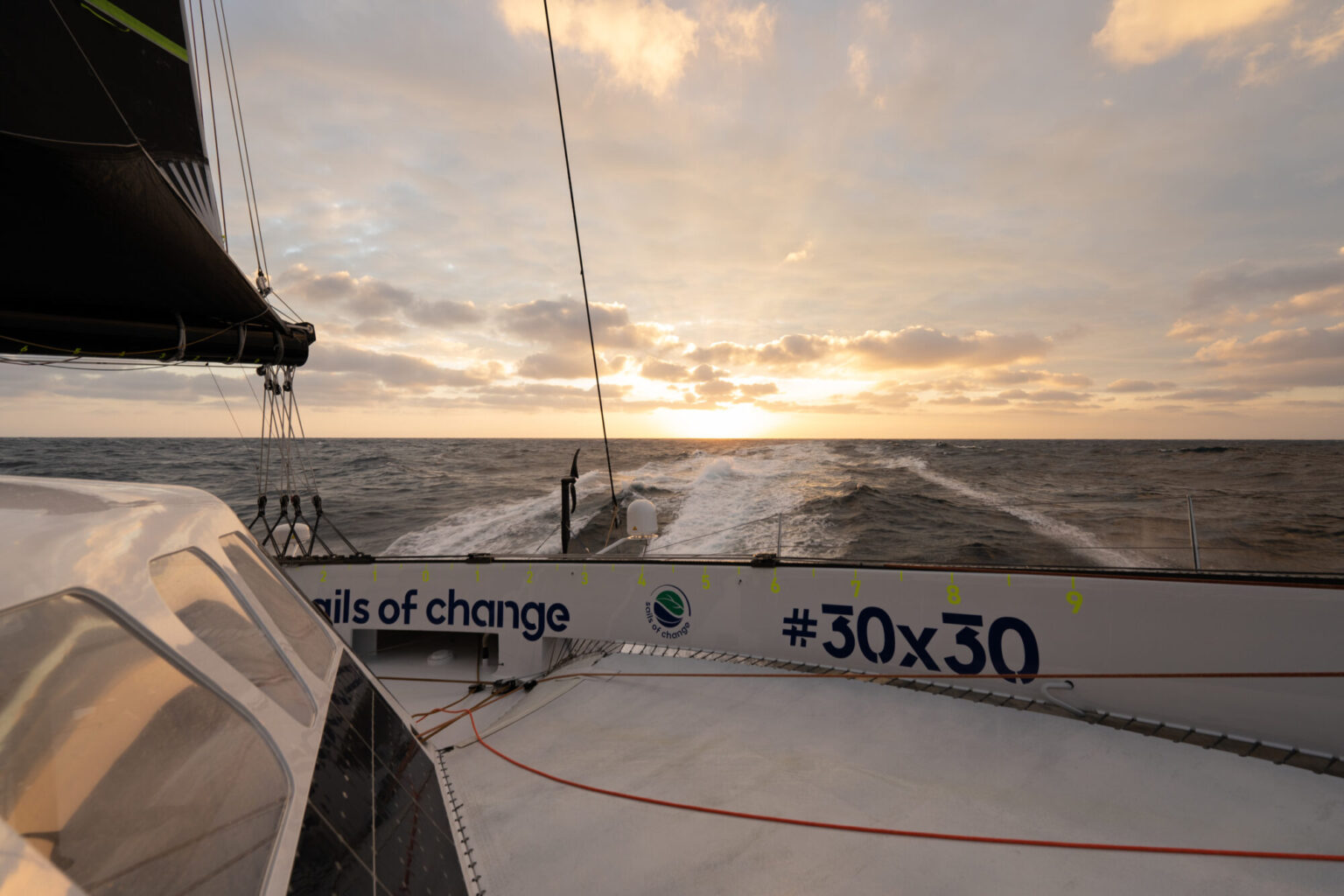
On standby from 1 November
The maxi-trimaran Sails of Change will set out from La Trinité-sur-Mer in south-west Brittany to make for the start line off Ushant as soon as there is a favourable weather window, with a standby commencing 1 November 2021.
Ten sailors with complementary backgrounds, five of whom have already circumnavigated the globe, will set sail alongside skipper Yann Guichard on this fourth crewed attempt. Two of them, Thierry Chabagny and Xavier Revil, won the Jules Verne Trophy in 2012, whilst Dona Bertarelli has held the title of fastest woman to sail around the world since 2016. In all, nine of the eleven sailors have previously been involved in a Jules Verne Trophy attempt. Only Julien Villion and Yann Jauvin will be making their Trophy debut in this legendary international offshore racing event.
Settling into life in the fast track!
Since Tuesday evening, at 20:37 UTC on the dot, and their departure from the dock in Lorient to make for the start line off the north-west tip of Brittany, the pace has continued to pick up for the men of the Maxi Edmond de Rothschild. At 02:26 UTC, on Wednesday 25 November, on a pitch-black autumn night on the back of a rainy front, the 32-metres giant crossed the virtual line stretching between Ushant and Lizard Point, the southernmost tip of England, thus triggering the stopwatch for its first Jules Verne Trophy attempt. Since that time, Franck Cammas, Charles Caudrelier and their four crew have already covered over 1000 miles in relation to the goal. This morning, they passed the latitude of the Azores and will this evening pass that of Madeira… The pace is quick, very quick, but of course that is the aim of a speed record. At the 14:30 UTC position report, the crew boasted a lead of 71.6 miles in relation to the record held by Francis Joyon and Idec Sport.
A corridor southwards
By setting sail from Ushant in the early hours of Wednesday morning, the Maxi Edmond de Rothschild’s weather cell, comprising the two skippers and their router Marcel van Triest, were targeting a vein of quite clean air, synonymous with high speeds along a virtually straight-line course towards the trade wind of the northern hemisphere and then on to the equator. However, this fine trajectory involves quite a work-up and aboard the latest addition to the Gitana fleet, the crew has had to quickly throw themselves in at the deep end.
In fact, during the passage of over 30 hours, the six sailors have had to put in two gybes to stay inside this corridor of breeze, with the emphasis on a number of headsail changes in a constant bid to adjust their trajectory to face the conditions, which Charles Caudrelier described yesterday morning as shifty: “The first night was lively and intense! The wind was very shifty and though the seas weren’t very high, they were very messy and we spent our first night under autopilot as it was impossible to hand steer.” Last night, whilst Gitana 17 was beginning her second day of the record attempt, the wind and the seas picked up considerably offshore of the Iberian peninsula with “4.5 to 5-metre waves and a powerful 25-30-knot NNE’ly breeze gusting up to 40 knots.” Suffice to say that being constantly powered up at over 30 knots is proving to be a bracing introduction for the sailors of Gitana Team.
The latest generation maxi-trimarans, of which the Maxi Edmond de Rothschild is the pioneer, are sending the speedos into turmoil at the start of this record. The 2019 edition of the Brest Atlantiques gave us a chance to witness this in action, with a blistering pace from the get-go and an express exit from the Bay of Biscay despite the boisterous conditions. A year on, history is repeating itself and the intensity of the start of this Jules Verne Trophy is certainly living up to expectations. At 13:45 UTC, the Cammas – Caudrelier pairing and their crew had devoured over 1,200 miles over the ground at an average speed of 35 knots!

A record attempt albeit with some semblance of a duel
“The writing of one of the legendary pages of this Jules Verne Trophy began last night”, stated Yann Eliès yesterday, during the live broadcast filmed at the Gitana Team’s base.
Indeed, it won’t have escaped anyone that not one but two boats set sail from the foot of Le Créac’h lighthouse in the early hours of Wednesday. Sodebo set off at 01:55 UTC and the Maxi Edmond de Rothschild followed in her wake 31 minutes later at 02:26 UTC.
These virtually simultaneous starts may be reminiscent of a race set-up, but there’s one key point to remember: the two giants are on the hunt for the record set by Francis Joyon and hence it is a race against the clock to better the time set by Idec Sport in 2017. However, it would be an untruth not to mention the adversary and the mano a mano currently playing out in the descent of the Atlantic.
“Setting sail as two boats? The idea of setting sail at the same time as Sodebo was very much on our minds since Thomas Coville team was on standby at the same time as us. From the outset, the prospect of two boats setting off was quite appealing. It’s a chance to emulate one another, added motivation! And in terms of safety it’s good too,” admitted Franck Cammas prior to the start.
SPINDRIFT 2 FORCED TO ABANDON RECORD ATTEMPT
AT 1900H UTC YANN GUICHARD, THE SKIPPER OF SPINDRIFT 2, CONTACTED HIS TECHNICAL TEAM ASHORE TO REPORT DAMAGE TO THE STRUCTURE OF THE STARBOARD RUDDER. SPINDRIFT RACING IS CHALLENGING FOR THE JULES VERNE TROPHY.
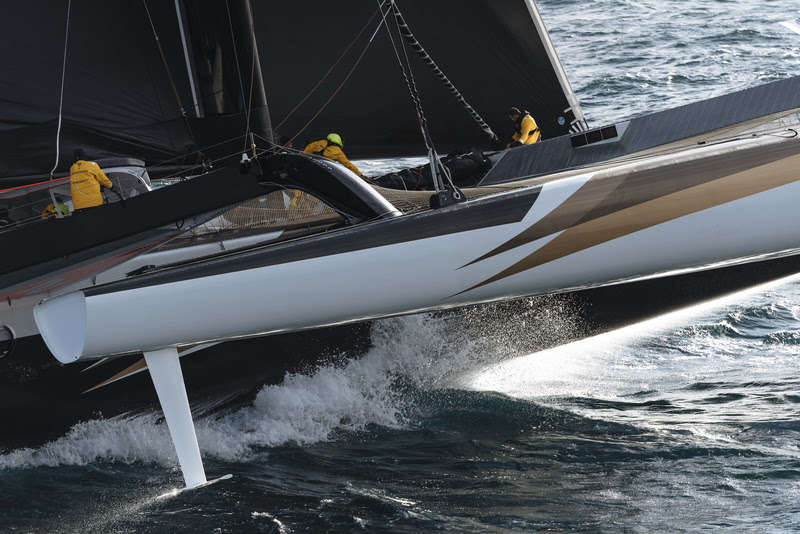
Having made a full assessment of the damage and possible repairs, the team has reluctantly concluded that they are unable to make the necessary repairs without compromising the safety and performance of the 40m trimaran.
“Because of this technical problem we have no choice but to stop this record attempt. It is a huge disappointment to all of the crew. We are now heading to the south west coast of Australia and expect to reach there in the next four days” confirmed Yann Guichard.
THE FIRST CAPE
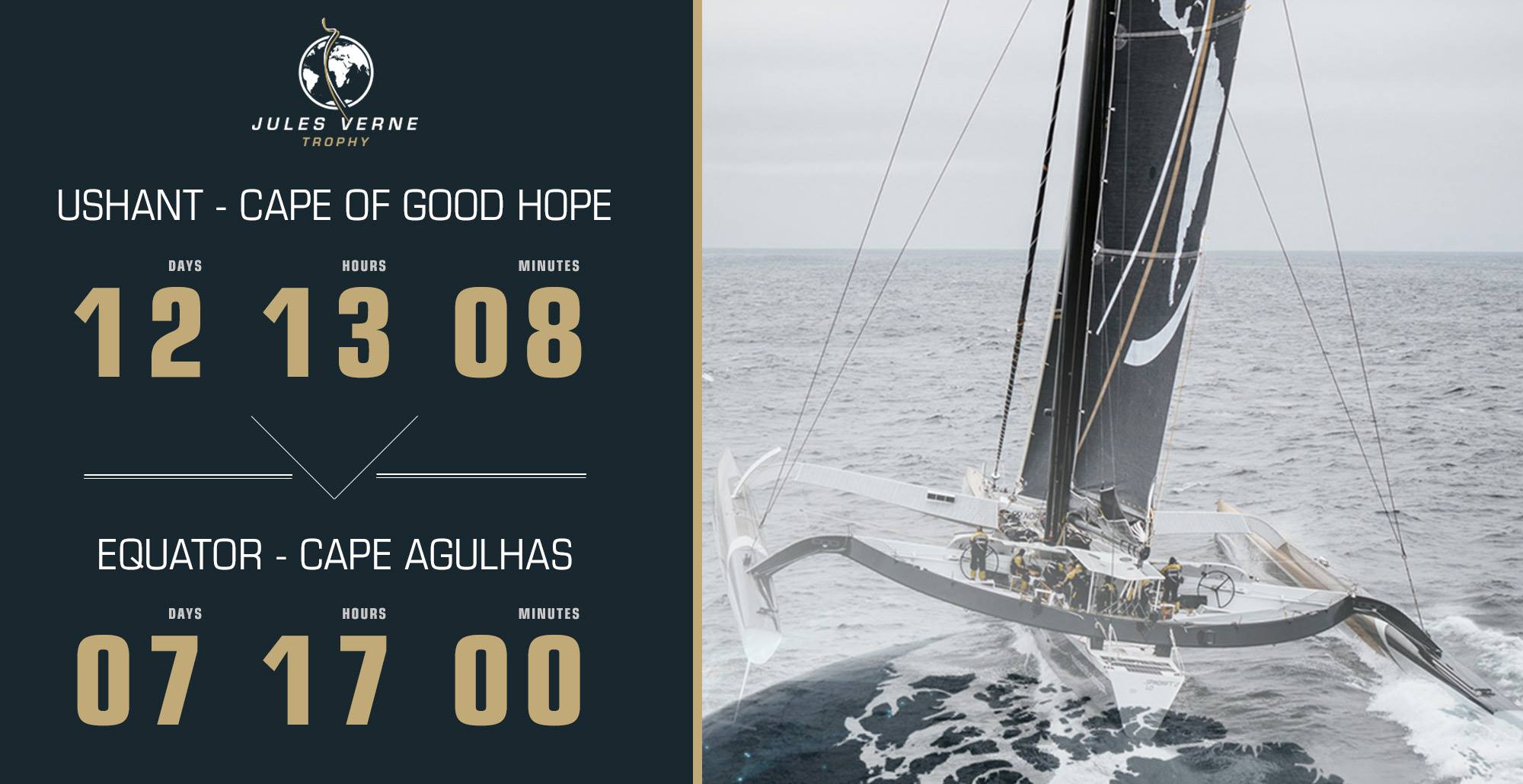
AFTER 12 DAYS, 14 HOURS, 58 MINUTES, SPINDRIFT 2 REACHED THE LONGITUDE OF CAPE AGULHAS ON TUESDAY AT 0240 UTC (0340 FRENCH TIME), SAILING FROM THE ATLANTIC TO THE INDIAN OCEAN. WHILST MAINTAINING THE LEAD ON FRANCIS JOYON AND HIS TEAMS’ WORLD RECORD OF 6 HOURS 43 MINUTES. IN ORDER TO REACH THIS POINT OF AFRICA, YANN GUICHARD AND HIS ELEVEN CREW MEMBERS HAD TO SAIL AROUND THE SAINT HELENA ANTICYCLONE TO BE ABLE TO BENEFIT FROM THE DOWNWIND SAILING OF THE SOUTHERN OCEAN, IN OTHER WORDS, A 700-MILES ROUND TOUR…
The first of the three symbolic Capes of this round the world sailing race, the Cape of Good Hope, was reached after just 12 days 13 hours 8 minutes: one of the best ever times of the Trophée Jules Verne, which first started in 1993. But it was several miles away to the South East, at Cape Agulhas, where the time reference comes into its own as this point of Africa marks the entrance into the Indian Ocean. However, in order to reach it, Spindrift 2 had to navigate around the Saint Helena anticyclone, go through an oceanic ridge and finally, take a left before heading towards Cape Agulhas.
Despite this detour, which forced the black and gold trimaran to dive South up to 43°, Yann Guichard and his 11 crew members keep a lead: 6 hours and 43 minutes, (equivalent to 300 miles) on the reference time of IDEC Sport, the current record holder. As a result, Spindrift 2 took 12 days, 14 hours, 58 minutes from Ushant to reach Cape Angulhas, and from the equator, 7 days 17 hours to go beyond this point in Africa.
A FAVOURABLE INDIAN OCEAN?
“We had to take a large detour to get around the Saint Helena anticyclone: we had to go down to 40° South before turning left! It was pretty extreme, but we didn’t have any other way of cutting across: we just had to grin and bear it, especially as we had had a crosswind and head seas which weren’t easy to navigate through… For three days we’ve been stepping up the pace and it feels good: we’ve just reached the Cape of Good Hope and we’re sticking to the targets we set out for ourselves.” said Yann Guichard after reaching Cape Angulhas.
Taking confidence from this reference time entering the Indian Ocean, which remains the third best time in the Trophée Jules Verne, the skipper, his crew and their onshore router, Jean-Yves Bernot, are pretty comfortable about the next stage as the Mascareignes Anticyclone (Southern Madagascar) is well placed on Crozet Island and will start to head North over the next few days towards the Kerguelen archipelago, pushed by a southern depression. At an average speed of over 35 knots for 3 days, the black and gold trimaran will be able to hold this steady pace through a relatively manageable ocean heading to south of the Kerguelen!
“The sun has been up for a couple of hours and we really know we’re in the Indian Ocean! We’ll be reaching 50° South soon, the weather’s grey and temperature of the water is 2°C… But with albatross at our side, it’s amazing! The conditions are on our side to help us reach Kerguelen quickly. We’ll leave the Kerguelen to the North as we’ll undoubtedly go down to 53-54° south. However, we’ll also have icebergs ahead of us from Wednesday: we’ll need to keep watch on the radar and with our infrared glasses. It’s looking a bit tense… We should sail the length of the anticyclone while being powered along by the southern winds: it’s looking pretty good up to the Kerguelen, but after that, we’ll have several gybes to go which will slow us down a little. We should still get through the Indian Ocean quickly without wasting too much time and hope to get to the Pacific, South of Tasmania with too much delay.” Mentioned the skipper on Spindrift 2.
If this southerly course enables the team to shorten their route while benefiting from a sustained current, going down to 53° South would present them with the problem of drifting ice and where a number of icebergs have been clearly located by the CLS satellites. On this stretch of the route, Spindirft 2 needs to be very fast because Francis Joyon and his crew made the Indian Ocean crossing extremely quickly as they still hold the WSSRC record (5d 21h 8m)! Having said that, the capabilities of the black and gold trimaran in the breeze give hope that it will retain the lead on IDEC Sport’s timing to South of Tasmania, the hot spot between the Indian Ocean and the Pacific.
EQUATOR RECORD!
ON MONDAY 21 JANUARY AT 07H45 UTC, SPINDRIFT 2 BROKE HER OWN RECORD BY JUST OVER AN HOUR, BY CROSSING THE EQUATOR IN 4 DAYS 19 HOURS 57 MINUTES. THIS ALSO GAVE THE BLACK AND GOLD TEAM AN ADVANTAGE OF MORE THAN 23 HOURS (180 MILES) OVER THE CURRENT HOLDERS OF THE TROPHY JULES VERNE, IDEC SPORT. THIS IS THE FIRST CHALLENGE IN THE TEAM’S QUEST TO BEAT THE ROUND THE WORLD RECORD. THE TIME FOR THE PASSAGE FROM USHANT TO THE EQUATOR STILL HAS TO BE OFFICIALLY RATIFIED BY THE WSSRC (THE INTERNATIONAL ORGANISATION THAT OVERSEES RECORDS), BUT YANN GUICHARD AND HIS CREW CAN BE PLEASED WITH THIS FIRST SECTION OF THE COURSE, AND BETTERING THEIR OWN RECORD TIME, SET IN 2015 (4D 21H 45′), BY 1 HOUR AND 48 MINUTES.
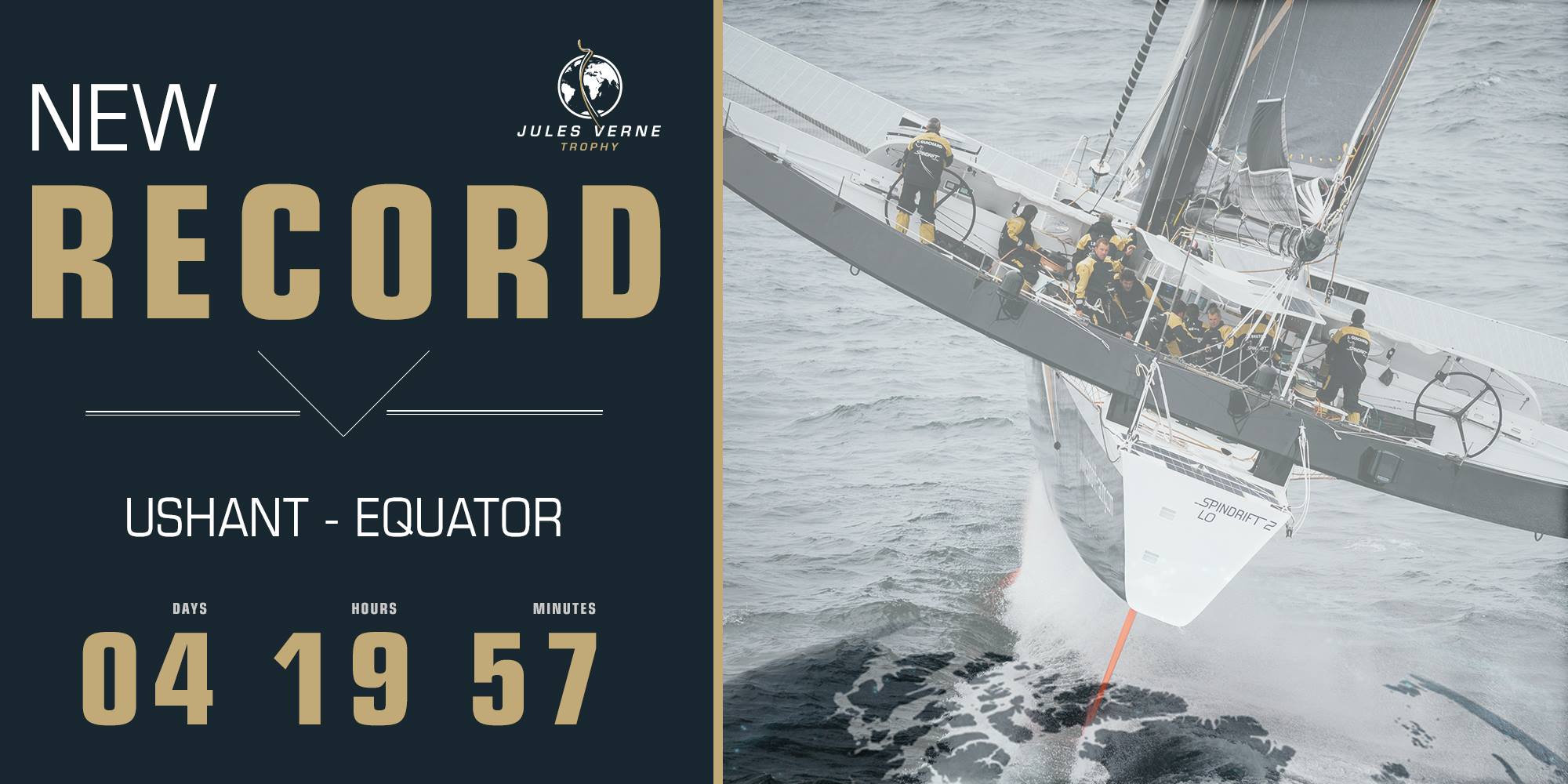
Spindrift 2 crossed the line in front of the Créac’h lighthouse on Wednesday 16 January at 11h 47 ’27’ UTC and quickly took advantage of the favourable conditions. The crew had to gybe the 40m trimaran about a dozen times to ensure that they stayed in the trade winds as they passed through the Canary Islands and and the island of Hierro.
Full moon!
“We entered the Doldrums at 2° North: they were not very active, so we had to get through in relatively little breeze, but it was especially nice to have the full moon when we crossed the equator: we even saw the eclipse! It was beautiful for a good hour … Everyone has really been on the pace and the modifications that we made to the coach roof have been a real bonus – we are definitely less exposed. The route to the equator was not easy: we had quite lumpy seas in the lead up to the islands, then we had to gybe a lot and pass right through the Canaries and Cape Verde archipelagos.” Commented Yann Guichard, a few moments after crossing the equator, the ‘line’ separating the north and south hemispheres.
However, the team is not out of the Doldrums yet, as they are currently stretching some 120 miles to the south of the Equator. The team will have a challenging six hours or so before they can hook into the south easterly trade winds blowing off Brazil. But the good news is that a strong front is due to leave Cape Frio (off Rio de Janeiro) on Tuesday.
“We will leave the Doldrums at about 2° South, and then we will have to get around St. Helena anticyclone that is forming to the East, so we will have to go to about 37° South before turning left towards the Indian Ocean. It makes the route longer, especially as we will have to cross a light weather area in three days, but we should then reach favourable NW winds. It will be a relatively slow descent … but we should be a little ahead of Francis Joyon and his crew by the time we reach Cape Aiguilles,” continued the skipper of Spindrift 2.
The next goal is the tip of South Africa: Francis Joyon and his crew crossed the longitude of the Cape Aiguilles after 12d 21h 22′ at sea. So, with a 23 hour advantage on this first stretch, Yann Guichard and his crew can hope to stay half a day ahead before entering the Indian Ocean. This same trimaran, when it was Banque Populaire in 2012, took less than twelve days from Ushant (11d 23h 50′).
Spindrift 2 still has some 3,200 miles to reach this longitude but the black and gold trimaran has been averaging 26 knots since leaving Ushant, and covering more than 620 miles a day – including the passage through the Doldrums!
Crew of Spindrift 2
Yann Guichard (skipper)
Erwan Israel (navigator)
Jacques Guichard (watch leader / helmsman)
Christophe Espagnon (watch leader / helmsman)
Xavier Revil (watch leader / helmsman)
François Morvan (helmsman)
Thierry Chabagny (helmsman)
Sam Goodchild ((helmsman / bow)
Erwan Le Roux (helmsman)
Duncan Späth (helmsman)
Benjamin Schwartz (helmsman / bow)
Jackson Bouttell (helmsman / bow)
Jean-Yves Bernot (onshore router)
Crew Split Times References
Ushant-Equator: 4d 19h 57 ‘(Spindrift 2 in 2019)
Equator-Cape Aiguilles: 6d 08h 55 ‘(Banque Populaire V in 2012)
Cape Aiguilles -Cape Leeuwin: 4d 09h 32 ‘(IDEC Sport in 2017)
Cape Leuuwin-Cape Horn: 9d 08h 46 ‘(IDEC Sport in 2017)
Cape Horn-Equator: 7d 04h 27 ‘(Banque Populaire V in 2012)
Equator-Ushant: 5d 19h 21 ‘(IDEC Sport in 2017)
WSSRC crewed records
Crossing the North Atlantic (Ushant-Equator): 4d 19h 57 ‘(Spindrift 2 in 2019) *
Crossing the Indian Ocean (Cape Aiguilles-S Tasmania) : 5d 21h 07’ 45’’ (IDEC Sport in 2017)
Crossing Pacific Ocean (S Tasmania-Cape Horn) : 7d 21h 13’ 31’’ (IDEC Sport in 2017)
Equator-Equator- : 29d 09h 10’ 55’’ (IDEC Sport in 2017)
Around the World (Jules Verne Trophy) : 40d 23h 30’ 30’’ (IDEC Sport in 2017)
*Waiting for ratification by WSSRC
ATLANTIC ‘DOOR’ CLOSED
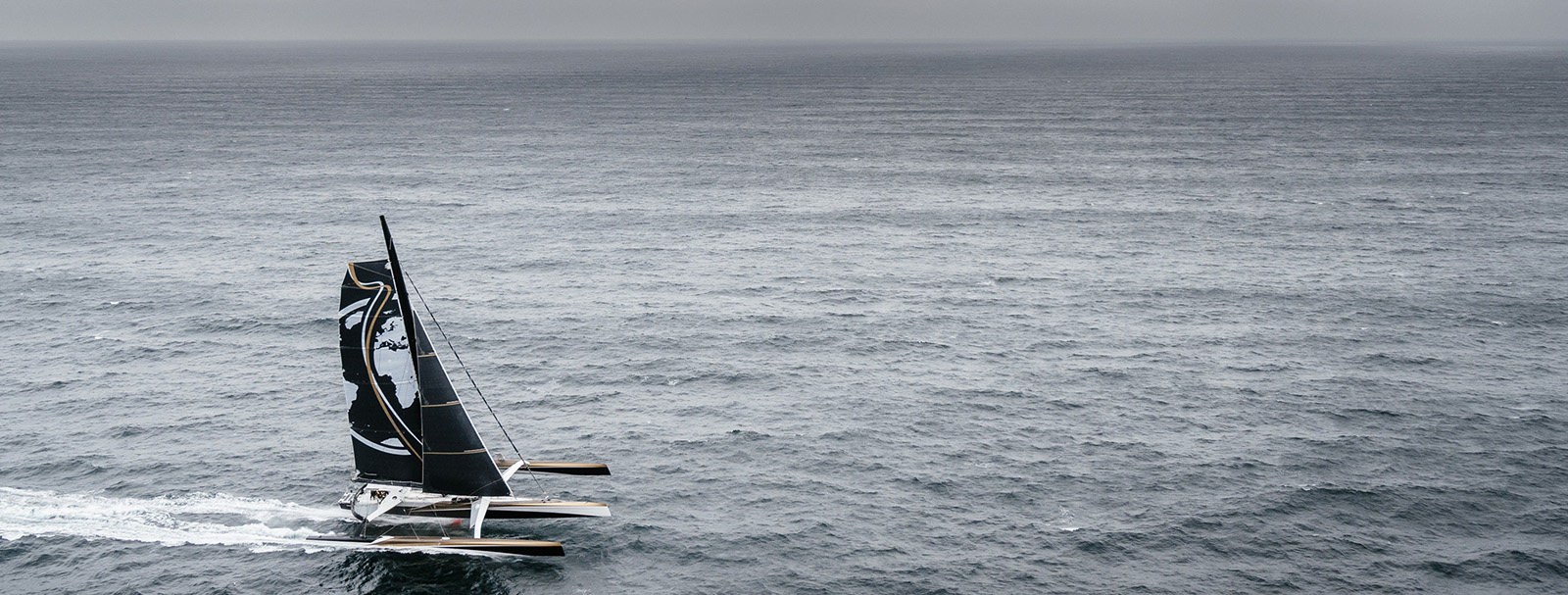
Yann Guichard and the crew of Spindrift 2 have been waiting since the 5 november for a favourable weather window to start the Jules Verne Trophy. Despite november being windy and the Atlantic experiencing a series of lows, the conditions have not been favourable enough for the team to reach the equator in good time. This first reference point in a world tours is also the only part of the course where the 7/8 day weather projection makes it possible calculate exactly how long it would take to reach it.
Jean-Yves Bernot, the maxi trimaran’s weather router, comments: “The situation is currently blocked by a low pressure system coming from the US coast to northern Europe. This creates strong southwesterly to westerly winds that remove any chance of reaching the equator within an interesting timeframe. In addition the sea state is very unsettled – conditions synonymous with damage to the boat. We therefore have to wait for the weather to develop and anticipate that, once the winds shift to the north-west or north-east and the weather pattern evolves, we can leave.”
Without these conditions no start is envisaged for Spindrift 2, however the crew is ready to take advantage of any change in the situation.

